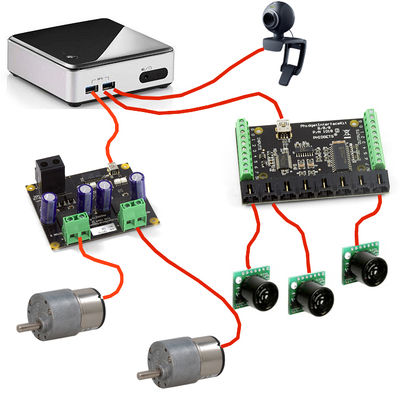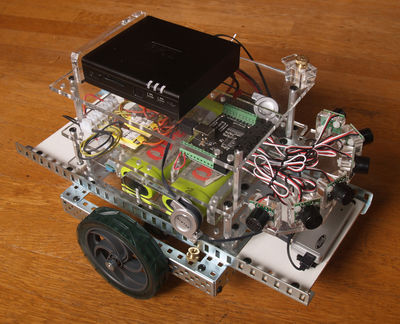Robot Floor Hugger
Contents
Why
The focus remains learning ROS, SW architecture, AI algorithms and navigation. Hardware was chosen based on materials on hand and electronics that don't get in the way. Phidgets are supported by ROS and because they are USB based are easily moved to new computer platforms. They have included the FitPC2, various Asus netbooks and finally the NUC. The NUC has been a welcomed relief because the i5 has the processing power to support ROS, OpenCV and the latest versions of Ubuntu.
Electronics
- Processor
- Intel® NUC Kit D54250WYK
- Detail page at NUC D54250WYK
- i5-4250U
- 16 GB RAM
- 120 GB SSD
- Ubuntu
- 14.04 LTS Trusty Tahr
- Intel® NUC Kit D54250WYK
- Actuators
- Controller
- Phidgets PH-1064
- Motors
- GH35GM Gearhead
- Detail page at Gearhead GH12-1926Y
- Controller
- Sensors
- Sonar distance
- Phidgets PH-1018 Interface
- LV-MaxSonar
- Vision
- Logitech Webcam
- Sonar distance
Power
TBD
See SLAM_with_XV_11_using_ROS#Power_and_Load
Log
- 4-11-16: 2 hours 20 minutes on battery it was at 74%
- 6-28-16: 2 hours 47 minutes on battery (5000 mAh, 6 cell, 22.2 volt). It dropped from 25.1 to 23.1 volts. It took 2223 mAh of charge. (808 mAh each hour at average of 24.1 volts is 19 watts.)
- 11-15-16: 2.5 + 1.0 hours => 3.5 hours (It dropped to 22.5 volts and took 2641 mAh of charge.)
Mechanical
This is an image of the Floor Hugger in 2009. There have been electronics upgrades and the addition of a webcam. This photo shows the FitPC2 which has been replaced with the NUC. Note the Vex metal and wheels. Plastic and miscellaneous other parts are also used. Again, the mechanics are meant to hold the components together so that I can experiment with the software. There is nothing creative here. For example, wireless is not enabled on the NUC and it is powered by an AC adapter. As a result, the robot is tethered. Parts are on order to fix that but autonomous motion remains a low priority while the software is the focus.

